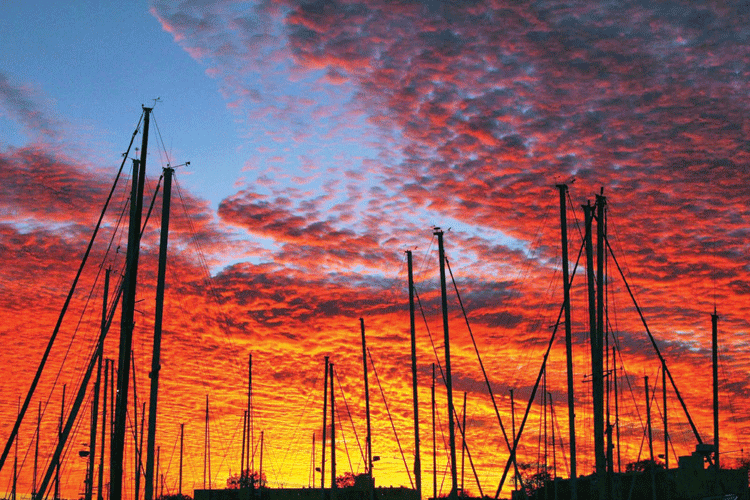Small boat racers on the Chesapeake will find helpful weather preparation tips in this condensed version of Kim Couranz's June 2017 Small Boat Scene article (which can be found in its entirety here), but sailors of all stripes may want to bookmark spinsheet.com/weather.
I’ve pretty much been fascinated by weather since the third grade. While I’m lucky to get to work with meteorologists and other atmospheric scientists on occasion at my day job, nowadays, the way I get to apply my weather love most often is in preparing for a day of sailing. While there are some fantastic firms that will produce very detailed local forecasts specifically to support regattas, those forecasts are quite pricey. I’ve found a handful of great and free resources that I’d like to share, along with how I generally approach getting my head around what weather might be like here on the Chesapeake.

Let’s say I’m sailing a Saturday-Sunday regatta here on the Bay. Early in the workweek leading up to the event, I’ll start paying a little better attention to the weather, beyond my usual “do I need a raincoat or sunscreen” kind of check. I start focusing on the big picture: how the weather systems are moving that could affect our region during the regatta.
An easy way to do this is to go to your local NOAA National Weather Service’s Weather Forecast Office page (for Bay waters from the mouth of the Potomac River north, go to weather.gov/lwx, for waters south of there, weather.gov/akq). Atop those pages is a key section: “Hazardous Weather Conditions.” This is where you’ll see gale warnings, small craft advisories, and other special notices.
From the map on your local Weather Forecast Office page, you can click on the area where you want to see the forecast; these forecasts generally extend five days out. Take a deeper dive. Scroll down the page you’re now on to the “Additional Forecasts and Information” section and click on “Forecast Discussion.” This will get you a wordy look at why the meteorologists think the weather will evolve as they have described in their forecast. Handy tip: click on the blue, underlined words to see their definitions.
As I get closer to regatta day, I start looking at forecasts with more details. In “Additional Forecasts and Information,” see the “Tabular Forecast” feature. This forecast shows hourly forecast conditions 48 hours at a time. For the northern part of the Bay, an “Hourly Weather Graph” is also available, and you can select which items you’d like to see on the graph, including wind speed, gust and direction, and wave height.
Another part of NOAA, the National Ocean Service, creates useful forecasts as well. In particular, we here on the Chesapeake are lucky because one of their efforts is the “Chesapeake Bay Operational Forecast System.” CBOFS provides forecasts for wind, water level, current, water temperature, and salinity. Visit tidesandcurrents.noaa.gov/ofs/cbofs/cbofs.html and then click on the location nearest where you’ll be sailing.
Water temperature is great to know—especially early in the season—to help decide what to wear. Current information gives you some clues as to how water will be moving on your race course. Remember, tide charts don’t tell the full story; recent rains and wind-driven water movement come into play as well, and the CBOFS model takes these into effect. The CBOFS water level model is useful for me in another way: it helps me know if I need to move my Laser on its dolly away from low-lying areas of the boat park in case of coastal flooding.
Of course, forecasts are just that: forecasts. And while the computer models they are based on keep getting better, they are not perfect. So when you head out to the race course, take that forecast with you as knowledge but not gospel. Day-of, it’s important to focus more locally, monitoring conditions near you, such as at the buoys in the NOAA Chesapeake Bay Interpretive Buoy System (buoybay.noaa.gov, 877-BUOY-BAY, or via free mobile apps) or simply through keeping your eyes open to the skies.
by Kim Couranz




